Homemade Ricotta Cheese Made with Malt Vinegar | Black Truffle Salt
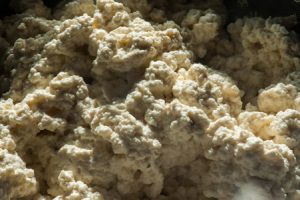 How to make your own homemade ricotta cheese:
How to make your own homemade ricotta cheese:
Cheese
The by product of milk. This homemade ricotta cheese recipe creates a unique flavor, that when mixed in a Duck Lasagna, incredible. As the milk is heated, a bay leaf gets a spa treatment, slowing warming and releasing its herbal and nostalgic essence into the dairy. Black Truffle salt is then added to a malt vinegar, boosting the umami as well as adding that earthy fungus aroma and taste to the rich whole milk.
When combined, the mixture coagulates, creating curds, separating from the whey. The curds are then strained through cheesecloth or a very fine strainer and depending on the use, stored or further drained to create a drier finished cheese. The technique of making this homemade ricotta cheese is the same as other recipes, yet flavored in a very different way.
Acid
Is responsible for curdling the milk, which makes this cheese. That acid can be from citrus, traditionally lemon, buttermilk, or vinegar (white distilled is very common). With this same approach, I wanted the finished cheese to have some more flavor, other than just the milk (while still showcasing the unique terroir that this dairy processes) and acid (lemon juice or vinegar). I love the flavor of malt vinegar and what it adds to the dairy’s soul, while leaving it’s fermented barley flavor. Sure you can use the store bought malt vinegar version, or you can also use a homemade version.
Salt
Is the best way to increase the flavor. Why use just regular unflavored salt? With something so delicate as the milk being used, the salt does make a difference. this recipe only uses 1/2 teaspoon of a Black Truffle Salt. A smoked salt could be added, or something with a unique flavor, that when using this finished ricotta, will add and give complexity to the final dish, but also give a supportive element to the texture that the cheese adds.
Milk
Is the largest mass of this recipe and this can not be overlooked. Most milk that is available to us is ultra pasteurized and homogenized. Pasteurization is the process of heating the milk, to kill any pathogens that may be present in the dairy product. This not only kills the pathogens but also changes the way milk tastes. It’s cooking the milk and sanitizing it. Ultra pasteurized is a this process done on a more heat and time principle, that further destroys the flavor and character the milk had, and gives it a longer shelf life, so it lasts longer. The notion of destroying the flavor to make it last longer is something I’ve struggled with for years. With so many cows in the USA, we don’t really have to worry about this.
Homogenized milk is the process of dissolving the fat rising cream into the milk, so that it won’t have cream floating on the top. This process also changes the flavor of milk we drink today. I like that memory of when I had milk as a kid and how i remember it tasting. Most of today’s milk has very little taste. Organic also helps develop flavor in the finish milk, as it also relates to the health of the cow, the farmer and the land they use to raise the cows. I recommend reading this article on Straus Family Creamery, as I feel this should he the norm and the standard for doing business.
Makes: 1 quart of ricotta cheese and 3 quarts of whey
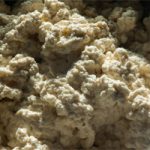
| Servings | Prep Time |
| 1 quart | 5 minute |
| Cook Time | Passive Time |
| 25 minute | 10 - 60 minute |
|
|

|
A homemade Ricotta recipe | technique using malt vinegar, bay leaf and Black Truffle salt, to create a savory style cheese.
|
- 1 gallon milk, whole for best results, non-homogenize, organic
- 1 each bay leaf, preferably fresh
- 1/2 cup vinegar, malt
-
1/2 teaspoon
salt, Black Truffle, such as Casina Rossa Truffle Salt
or other flavored salt
- 1/2 teaspoon salt, kosher
- Place the Dutch oven or large wide pot, preferably with a thick core bottom, to prevent hot spots over a burner on the stove top. Add the whole milk.
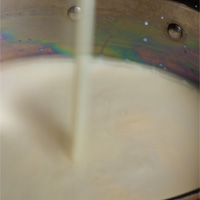
- Add the bay leaf to the milk. One could replace or combine bay leaf with a few sprigs of thyme, rosemary (a little goes a long way), oregano, marjoram, lemongrass, kaffir lime leaf, lemon peel, orange peel, peeled garlic clove, etc...) to add more flavor to the finished ricotta.

- Measure out the malt vinegar. Add the salt (Black Truffle Salt
or other flavored salt) along with or kosher salt (substituting all flavored salt for more flavor) to the vinegar and stir to dissolve the salt.
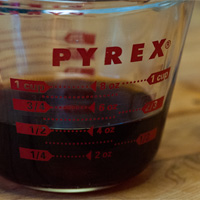
- Warm the milk to 200°F | 93°C, over low heat. Using a wide edged rubber spatula to periodically stir | scrape the bottom of the pot, minimizing and the milk from scalding. This low temperature will also help prevent scalding.
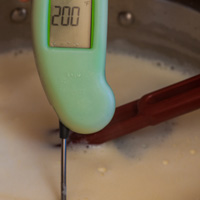
- Once the milk is at 200°F | 93°C, turn off the heat and add the malt vinegar | salt solution. Stir the mixture to fully incorporate the vinegar into the milk. Over the next minute, the warm milk will curdle, creating small curds, separating from the whey. Let this mixture sit for 10 minutes to fully separate the curds from the whey.
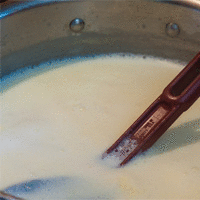
- Line a stainless steel colander with either several layers of Cheesecloth
or a fine stainless steel strainer. Place the colander into a large bowl, to capture the whey. Pour the curds and whey into the strainer, removing all the curds from the pot.
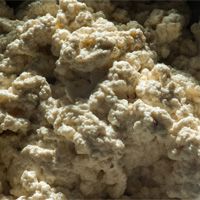
- To create a wetter style ricotta cheese, you can drain it, then immediately transfer it to a quart size wide mouth canning jar and allow to cool, then seal and refrigerate. This will create more of a spreadable version of ricotta, as not all the whey has been removed. This is perfect for appetizers, crêpe, Barley Cavatelli Pasta or other recipe calling for a whole milk ricotta.
- To make a drier ricotta cheese, perfect for pasta ravioli or a pizza topping, let the curds drain the whey for 10 - 60 minutes. Then transfer it to a quart size wide mouth canning jar, seal with its lid and refrigerate.
- To make the dry style ricotta creamy again, you can add some of the reserved whey or add heavy or whipping cream, 1 - 4 tablespoons, stirring to get to the desired textured cheese, for its final use.
- Whey is the byproduct of cheese making. This medium is still nutritionally rich and can be used for many different kitchen creations. Whey is still full of lactose (milk sugar) and whey proteins (casein protein is what has transformed into curds and been removed). Cool the whey, transfer to a canning jar and refrigerate up to 7 days or freeze (in ice cube tray) for up to 6 months. In an effort to use all the milk product, since you've paid for it already, here are some suggestions on what to do with the whey.
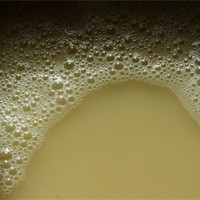
- Baking: Whey can replace water in many different baking applications, from pizza crust, rolls, focaccia, crackers to used ice cold to make pie crust. Taste the whey, seeing how salty it is and adjust the recipe, if savory or sweet, accordingly. The resulting baked goods will have a more tender structure than if made with just water.
- Smoothies: Whey is used in many smoothies or breakfast drinks. Instead of using milk or yogurt, use this whey to get the desired consistency, that is pourable.
- Animal Feed: Many different animals are fed whey, instead of pouring it down the drain. In the culinary valley of Tuscany, Parmigiano-Reggiano cheese makers in the small town of Reggio Emilia give the leftover whey to pigs in the neighboring town of Parma. This is one of the major differences in the pigs used to make prosciutto, as the whey sweetens the meat with the leftover lactose and casein protein.
- Stock: To make stock, vegetable, poultry (chicken | turkey | duck) or meat (beef | veal | lamb | venison), whey can be added, replacing the water entirely. If this finished stock is going to be used to make a sauce, especially a demi glaze, be careful of the salt, that is still present in the whey, from the cheese making process.
- Soaking Medium: Dried beans, rice and other starches can be soaked and cooked in whey, adding the extra nutrient to the starch.
- Fermentation: Whey can be added to a Lacto Fermentation, speeding up the lactobacillus with this nutrient rich liquid. You might need to adjust the salt % of the solution, accounting for the additional leftover salt in the whey.
- Watering: You can water your vegetable garden with whey, giving your soil and veggies a kick of nutrients.
Recipe Variations:
- Hopped Ricotta Cheese: Substitute the bay leaf for 3 - 6 hop cones, to infuse the flavor of hops into your ricotta. The fresher the better, to get the best hop flavor into the milk. Citrus, herbal, resin | pine, earthy, dank or tropical varieties of hops will change and design the finished ricotta with a true Beer Cuisine flavor. When using this variation, think about the beer being paired with the dish, using this recipe. Using the same variety of hop that was used to make the beer being paired will add a building pairing element.
Recipes That Use This Recipe:
- Duck Lasagna
- Barley Cavatelli Pasta



